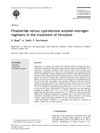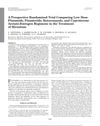TLDR Androgens and SARMs play a role in body mass, frailty, skin health, and hair growth, and are used in treating prostate cancer, acne, and hair loss, with potential for new uses and improved versions in the future.
In 2002, George F. Allan and Zhihua Sui reviewed the role of androgens and selective androgen receptor modulators (SARMs) in various physiological functions and diseases. They noted that declining androgen levels with age can lead to decreased lean body mass and increased frailty. They also discussed the potential link between androgens and prostate cancer, and the use of androgen antagonists in treating prostate cancer and benign prostatic hyperplasia, despite their side effects. The authors also highlighted the role of androgens in skin health and hair growth, and how excess androgens can cause acne and alopecia. They predicted that androgen antagonists would continue to be used in treating prostate cancer and would likely be approved for new uses, such as treating hirsutism in women, alopecia in men, and acne in both sexes. They also foresaw the emergence of new SARMs with improved tissue specificity. The authors were optimistic about the potential of SARM agonists to increase lean body mass and muscle strength in hypogonadal men and in patients with cancer and immunodeficiency, thereby counteracting frailty associated with aging.
 39 citations
,
August 2004 in “International journal of gynaecology and obstetrics”
39 citations
,
August 2004 in “International journal of gynaecology and obstetrics” Finasteride and CPA-EE2 equally reduce hirsutism, but affect hormone levels differently.
74 citations
,
August 2002 in “Clinical Endocrinology” Flutamide and CPA are more effective than finasteride for treating acne in hyperandrogenic women.
27 citations
,
January 2001 in “Hormone Research in Paediatrics” Low-dose flutamide effectively maintains reduced hirsutism with no side effects.
37 citations
,
January 2000 in “International Journal of Pharmaceutics” Topical treatments can regrow hair on bald scalps.
 113 citations
,
April 1999 in “The Journal of Clinical Endocrinology and Metabolism”
113 citations
,
April 1999 in “The Journal of Clinical Endocrinology and Metabolism” Cyproterone acetate-estrogen most effective for hirsutism, but consider side effects and patient needs.
 20 citations
,
January 1999 in “Current Pharmaceutical Design”
20 citations
,
January 1999 in “Current Pharmaceutical Design” Antiandrogen therapy is effective and well tolerated for treating women's androgenic disorders like hirsutism, acne, and hair loss.
 18 citations
,
January 1998 in “Endocrine”
18 citations
,
January 1998 in “Endocrine” RU58841, a nonsteroidal anti-androgen, showed potential as a topical treatment for hair loss, increasing hair density, thickness, and length without systemic side effects in Stumptailed Macaques.
129 citations
,
January 2004 in “Journal of medicinal chemistry” Researchers developed new compounds that target the androgen receptor effectively with fewer side effects.
209 citations
,
March 1998 in “Biochemical and biophysical research communications” Scientists found new nonsteroidal compounds that can act like natural male hormones and might help treat male fertility and hormone issues.




